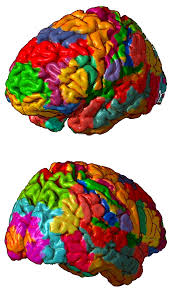Here are Diseases of Language Disorders And Disorder of Higher Functions are discussed.The importance of Callosal Syndromes and Gerstmann Syndrome is alse jotted down.
Apraxia.
Apraxia is the inability to perform a learned act in response to a stimulus which would normally elicit it, and which cannot be accounted for by weakness, incoordination, reflex change, sensory loss, incomprehension, inattention, or uncooperativeness. Three lesions may produce apraxia. With lesions of the corpus callosum there will be apraxia of the left side of the body, but not of the right or of the face. Patients with Broca’s aphasia (who usually have a right hemiplegia) will show apraxia that is usually most marked in the face and is also often present in the left limbs. With lesions in the left parietal operculum, producing a conduction aphasia, there is usually apraxia in the face (where it is most marked) and in the limbs of both sides of the body. In all forms of apraxia whole-body movements, e.g., “stand up,” “sit down,” “turn around,” and movements of eye-closing and eye-opening are best preserved. In all forms of apraxia the defect is most marked to verbal command (although the patient comprehends), usually somewhat less marked on imitation of the examiner, and least marked in the handling of objects, although in some patients even this latter category is impaired.
Agnosia.
Agnosia is a failure of recognition of complex stimuli in the face of preserved elementary perception. The most common form is visual agnosia, in which there are usually bilateral posterior occipital lobe lesions. The agnosias are less well understood than the aphasias or apraxias
Callosal Syndromes.
These were first brilliantly described by Hugo Liepmann in the early 1900’s, but have been rediscovered only in recent years. In some cases of anterior cerebral artery occlusion there is infarction of the anterior four fifths of the corpus callosum. The patient will carry out verbal commands with the right hand but not the left. He will name objects held concealed from vision) in the right hand but not the left. He can, however, with the left hand draw or select from a group of objects the one previously held in the left hand. He manifests, in brief, inability to transfer information between the two hemispheres. Involvement of the splenium of the corpus callosum plays a role in alexia without agraphia see Aphasia).
Gerstmann Syndrome.
This consists of agraphia, right-left disorientation, acalculia difficulty in carrying out calculations), and finger agnosia (inability to name fingers or to identify them). The patient almost invariably also shows constructional disorder, i.e., a difficulty in drawing or copying designs, especially three-dimensional ones. When all the components of this syndrome are present, the lesion almost invariably lies in the left posterior parietal region. It should, however, be kept in mind that a single component has .little localizing value. Thus constructional difficulty without the other components may result from lesions in many locations.
Right Hemisphere Syndrome. Lesions of the right parietal region produce constructional difficulty that is more severe on the average than that produced from any other site. Patients with lesions in this location may also show a dressing disorder manifested by great difficulty in putting on clothes. Milder degrees of the difficulty may be brought out by such maneuvers as putting one sleeve of the bathrobe inside out; the patient may be unable to get the bathrobe on properly.
A striking feature of acute lesions of the right hemisphere is anosognosia, i.e., a tendency to deny or neglect disability, or when admitting its presence, to be.unconcerned with it. It is a common experience that the patient with an acute left hemiplegia will show this type of behavior, although by contrast the patient with an acute right hemiplegia will, even if aphasic, show appropriate awareness of disability and will be depressed. These disorders in right hemisphere lesions are usually accompanied by a curious mental state, in which the patient shows apathy, poor attention, and often jocularity. These states (and the accompanying unconcern with illness) are usually transient, but are sometimes permanent in cases of- large right parietal lesions. Patients with transient cases, however, do not necessarily have parietal lesions.
It should be noted that not all patients who deny illness suffer from right hemisphere disease. Weinstein has shown that a patient with any disability may deny illness if he is sufficiently obtunded. Thus a patient may deny blindness resulting even from disease of the eyes if he develops a confusional state from metabolic disorder or drugs.
